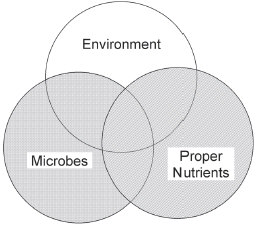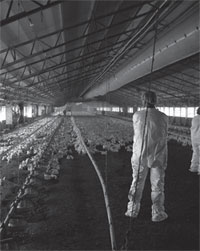



<i>E. Coli </i>an Opportunist that Causes Enteritis
By Vijay Durairaj and F. Dustan Clark, Center of Excellence for Poultry Science, University of Arkansas. Published in Avian Advice, volume 9, number 3.| More on the Author | |
| Dr. Dustan Clark Extension Poultry Health Veterinarian |
|
Introduction
Enteritis caused by Escherichia coli (colibacilliosis) is an important disease in the poultry industry because of increased mortality and decreased performance. E. coli is a bacterium that can not be seen without a microscope and is often considered an opportunistic pathogen because it infects whenever it has the opportunity. E. coli is a normal inhabitant of the intestinal tracts of animals and is harmless as long as it is kept in check by other intestinal bacteria (Barnes et al., 2003). When an imbalance occurs in bacterial flora of the intestinal tract, E. coli may grow and cause an outbreak of colibacilliosis. Chickens of all ages are susceptible to colibacilliosis, but usually young birds are considered more susceptible.
Signs of E. coli enteritis
Since E. coli is an opportunistic pathogen and will (given the chance) attack a number of organs, infections can cause a wide variety of signs or symptoms. Symptoms may range from sudden death of the bird to a vague sense that the bird is not doing well. Symptoms will also depend on the age and general health of the bird. Generally, birds will appear unthrifty and have ruffled feathers. They may also be depressed and have a decreased appetite. During the acute phase of disease you may also notice yellowish colored droppings and birds may be soiled in the vent region.
The cause of E. coli infections
E. coli enteritis does not fit the classic definition description of an infectious disease. This classic disease definition states that one microbe causes a given disease and that the illness can be reproduced in the laboratory by infecting susceptible animals with that one microbe (McMullin, 1998).
E. coli is normally present in the birds and the disease can be triggered by numerous events (see Figure 1). Immunosuppressive diseases such as Infectious Bursal Disease, Marek’s disease, and Chicken Anemia may increase susceptibility to E. coli infection. However, other countless events or diseases can also increase susceptibility. For instance, an E. coli infection may appear if birds do not have regular access to feed or if their litter is too wet or if they are exposed to another disease. Generally, anything that causes stress in the bird may provide E. coli with the opening it needs.

Adapted from McMullin, 1998
Once on E. coli outbreak happens, conditions may be right for the disease to “feed on itself,” and affect the entire flock. For example, if a significant number of birds develop diarrhea, litter moisture can increase, infecting more birds and, in turn, causing more wet litter. Consequently, the best approach to E. coli infections is prevention rather than control.
Prevention of E. coli Infections
 |
Controlling all of the factors shown in Figure 1 is imperative if growers are to control E. coli infections. As the figure implies, these factors are interrelated.
A stressful house environment can easily encourage E. coli infections. As mentioned, wet litter can encourage infection, but most growers realize that wet litter is often related to inadequate ventilation rates. Regular and frequent checking of houses is also important, particularly as it involves collecting the dead. Since commercial strains are bred to eat, preventing stress means providing easy access to water and feed is also important.
Growers tend to think that the company nutritionist and the feed mill are the only ones responsible for the nutrition of the birds. Although the nutritionist and feed mill personnel bear much of the responsibility for bird nutrition, growers are the last link in the chain. If growers do not store feed in clean, dry tanks and ensure that feed is properly delivered to the feeder pans, then birds do not receive the nutrition they need.
Since infection with another microbe can increase the probability that birds will break with an E. coli infection, it is also important to reduce or prevent the exposure of your birds to pathogens. How do these pathogens arrive on the farm? Human visitors are likely the largest source of pathogen exposure. Thus, it is important to limit the number of visitors and insist that visitors wear protective equipment (e. g. disposable boots, coveralls and hair nets) during their visit. Rats, mice and wild birds are another important source of pathogen exposure so a vermin control program is essential.
Summary
In summary, E. coli is an opportunistic pathogen that can produce a variety of symptoms in commercial poultry. E. coli is present in the birds and the poultry house environment and infects birds. However, if growers provide birds with proper house environment, ensure that they have easy access to feed and water as well as limit exposure to pathogens, E. coli infections can be limited or eliminated.
References
Barnes, H. J., J-P. Vaillancourt and W. B. Gross. 2003. Colibacillosis. In: Diseases of Poultry, 11th ed., Iowa State University Press, Ames, IA, USA.
McMullin, P. 1998. Wet litter in turkeys: Diseases and Interactions. Presentation at ADAS.NFU Turkey Conference http://www.poultry-health.com/library/turkeys/adastu98.htm Visited 8/10/07








